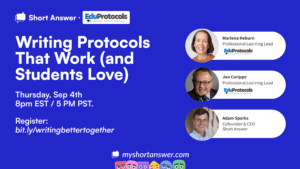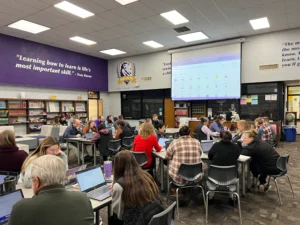I presented at the Wisconsin Educational Media & Technology Association (WEMTA) spring conference in Rothschild, WI this past March. While there, I attended a session called Inquiry Based Learning (IBL) led by Jake Boll, a curriculum specialist at CESA 5 in Wisconsin. It was the first time I’d heard about IBL and, as a former social studies teacher, it was an approach I immediately connected with. The video above and blog below are my attempts at explaining what IBL is, why it’s important, how it might look in the classroom, and useful resources to get you started with it.
What is Inquiry Based Learning?
IBL is a learning framework in which students are encouraged to ask questions, investigate topics, and use their findings to build an understanding or solve problems. What’s exciting about that, to me, is that it is a genuine shift toward a more learner-centered classroom: Students are empowered with real agency in the classroom to drive the learning experience. It’s a shift from a teacher-centric model where educators impart knowledge and students react accordingly, to a learner-centric model where the student actively seeks knowledge and the teacher serves as a guide. It generally follows a 4-step process.
4 Steps of Inquiry
- Questioning: The learning process begins with students asking questions about a topic or a real-world problem. These questions stem from curiosity and a desire to understand or explain a particular phenomenon. These questions correlate to key learning standards but, importantly, they are unique to each student or each class.
- Investigation: After formulating questions, students undertake research or experiments to find answers. This process might involve conducting interviews, searching the internet, reading books, or carrying out experiments.
- Analysis: Students analyze the gathered information, synthesize new knowledge, and draw conclusions. They are encouraged to think critically about their findings and challenge preconceived notions.
- Communication: Lastly, students communicate their findings to others. This might take the form of presentations, written reports, or interactive discussions, which not only reinforce the acquired knowledge but also develops their presentation and communication skills.
IBL in a "See-ChatGPT-Before-Me" World
The steps above might sound simple and in line with activities many teachers are already doing, but the implications are profound. By shifting the responsibility of the learning experience from the teacher to the student, students take control of their learning. This is in line with one of the core principles of formative assessment that is at the heart of our work at Short Answer: Activating students as owners of their own learning. The teacher transitions to a facilitator and guide, assisting the students’ inquiry process while making sure it still aligns with the learning standards of the class.
This reorientation feels particularly important in our current moment given the impact that generative AI is having, and will continue to have, on traditional classrooms. A recent Walton Family Foundation study found that 51% of teachers in the US are already using generative AI tools like ChatGPT. Even more impressively, 88% of teachers and 79% of students say that it’s had a positive impact on their learning. Given how early Generative AI is in its lifecycle relative to the impact it’s already having, it’s clearly going to have a massive impact on the future of our education system. When I reflect on this in relation to my own personal learning and the way I’ve seen students using it in the classroom this spring, I have little doubt that these tools will become the norm in the classroom. I (like many) see them eventually becoming personal tutors for students.
I used to use a teaching strategy called “See-3-Before-Me” in which I required students to seek out help from at least 3 classmates before asking me a question. The goal here was to lighten my load as an educator while also developing students as owners of their own learning. I can easily see a future where this strategy transitions to “See-ChatGPT-Before-Me.” As we barrel on toward that reality, it feels like we’re headed towards classroom structures in which student-initiated, inquiry-based exploration will be the norm. This only heightens the importance of us teaching the process effectively to our students so they can shape their own learning in valid, meaningful ways.
6 Resources to Get Started with IBL
1. Jake Boll’s 2023 WEMTA presentation referenced above would be a good place to start. In it, you will find links to inquiry templates, slide decks, posters, and more. Also, if you’re in Wisconsin this summer, check out Jake’s IBL Learning Workshop through CESA5 in July!
2. If you really want to get into IBL, Dive Into Inquiry by Trevor Mackenzie would be a great place to start.
3. Short Answer. Our (free) peer feedback platform is well-suited to facilitate each step of the inquiry process described above. We’ve even created a brief video walkthrough in which we explain 4 activities you could do with your students to support IBL work.
4. A 2020 study showing IBL’s positive impact on student critical thinking skills.
5. A 2017 study showing “inquiry-based learning had positive effects on participants” understanding of the complexity of educational issues and the process of inquiry.
6. A 2020 review of IBL research showing its positive impact on student learning outcomes.








